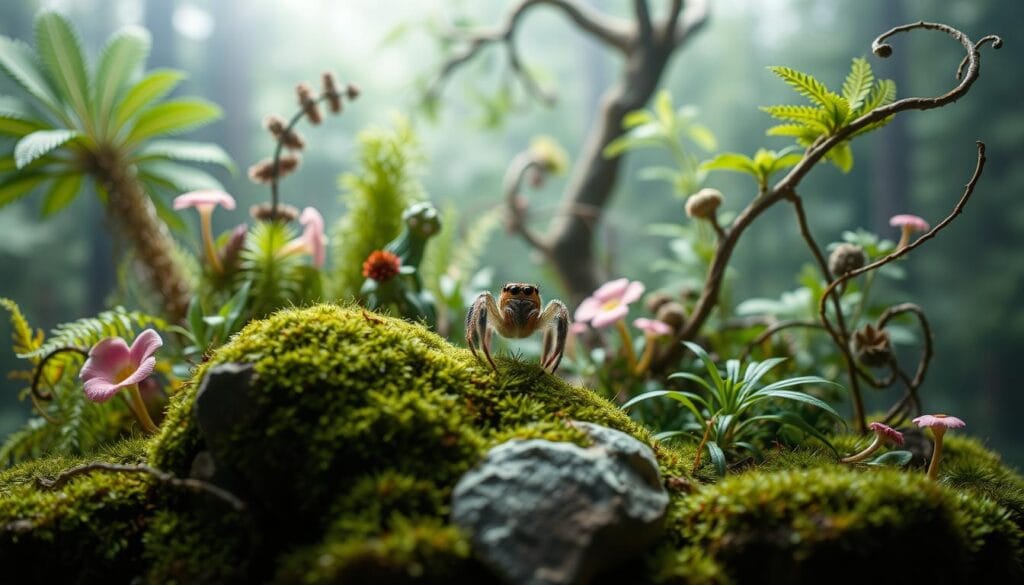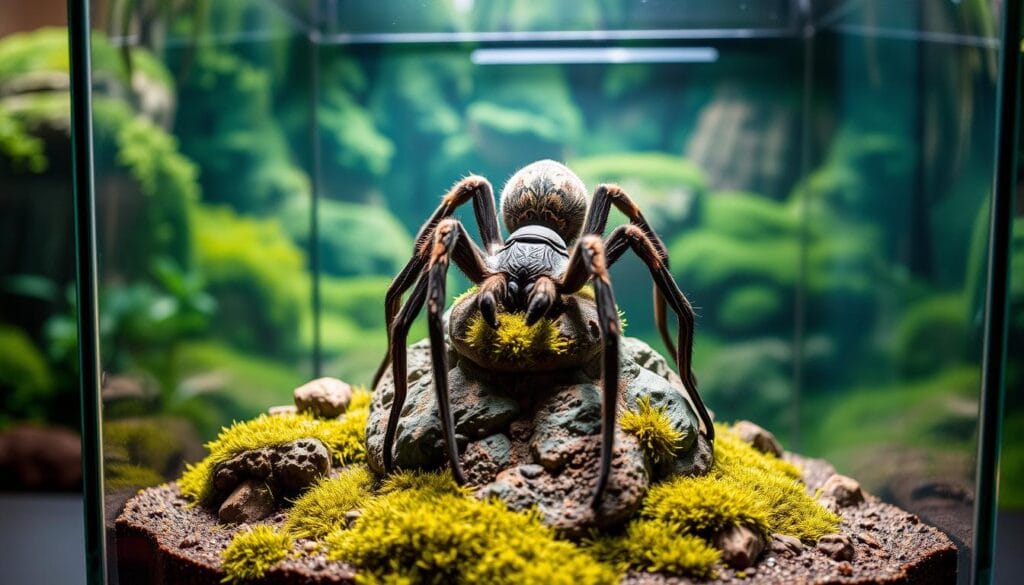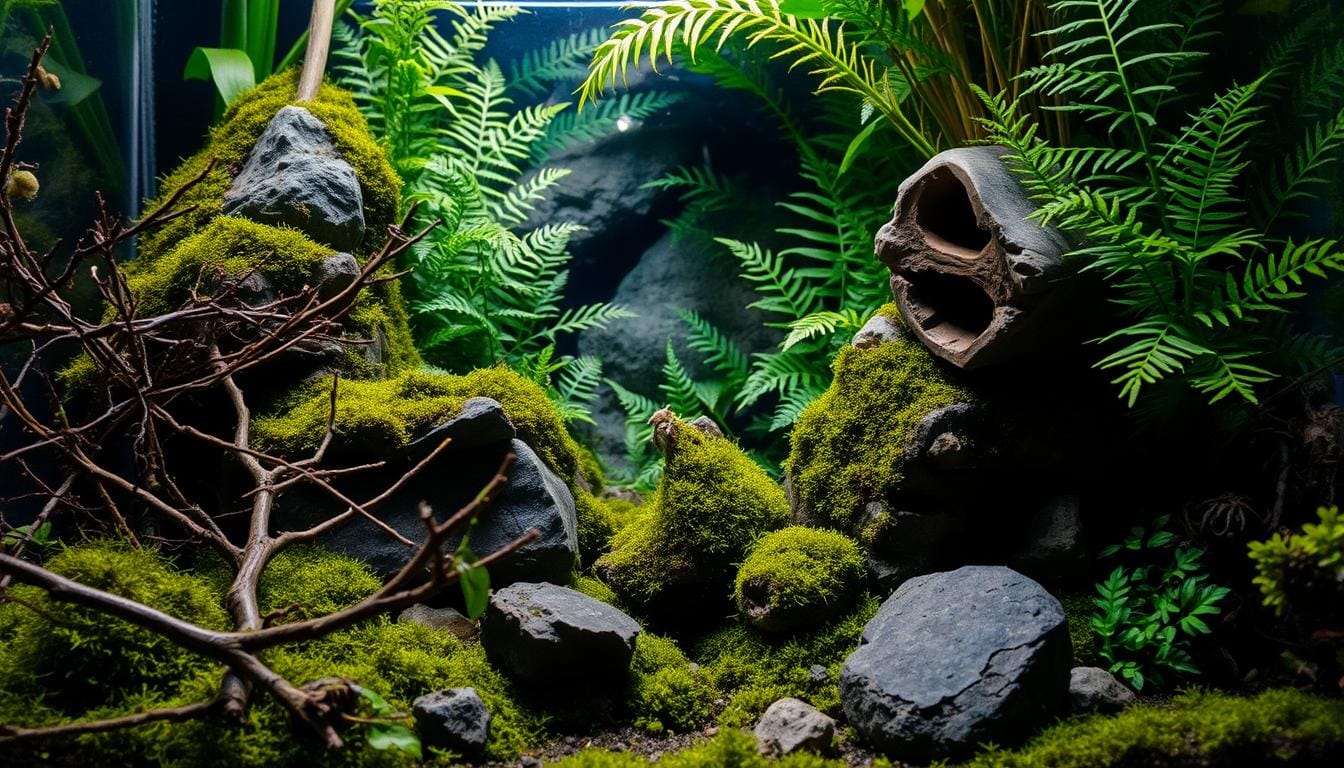If you’re a pet owner, you want to make a space that highlights your pet’s special traits. For Jumping Spider lovers, this means setting up a terrarium that looks good and works well.
Adding the right decor elements can turn your terrarium into a paradise for your pet. We’ll look at different ways to make your terrarium’s decor stand out and create a fascinating home for your Jumping Spider.
Table of Contents
Why Choose Jumping Spiders for Your Terrarium?
Jumping spiders are a great choice for terrariums. They are interesting and easy to care for. Their unique traits and behaviors make them perfect for spider lovers.
Unique Characteristics of Jumping Spiders
Jumping spiders can jump far for their size. They use this skill to catch prey and move around. Their behaviors are also quite fascinating.
- They can jump long distances compared to their body size.
- They have complex courtship dances.
- They have excellent eyesight for hunting and navigating.
When setting up your Spider Habitat Decor, think about their natural home. Use rocks, plants, and driftwood to make a fun environment.
Benefits of Keeping Jumping Spiders
Keeping jumping spiders can be very rewarding. They are easy to care for and can live well in a good terrarium. Some benefits include:
- They are fun to watch and can entertain you for hours.
- They need little space, making them perfect for indoor terrariums.
- They can teach you about responsibility and arachnid biology.
Adding Arachnid Enclosure Accessories like hiding spots and climbing structures can make their home better. It also helps them behave naturally.
Ideal Terrarium Conditions for Jumping Spiders
To keep your jumping spiders healthy, you need to create the right environment. This means the right humidity, temperature, and substrate. Important things to consider are:
- Keep the temperature between 65-75°F (18-24°C).
- Make sure the humidity is between 50-70%, depending on the species.
- Choose a substrate that holds moisture but also drains well.
By designing your terrarium with the right conditions and Arachnid Enclosure Accessories, you can make a great home for your jumping spiders.
Essential Terrarium Components for Jumping Spiders
Setting up a terrarium for your Jumping Spider requires careful thought. You need to include several key elements to ensure a healthy environment.
The terrarium’s size is crucial. It should be big enough for your spider to explore and hunt. A 5-gallon terrarium is a good start, but bigger ones offer more room for decoration and environment creation.
Choosing the Right Size Terrarium
Finding the perfect terrarium size is important. It ensures your Jumping Spider has enough space to move. Here are some important points to consider:
- A larger terrarium helps control temperature and humidity better.
- More space lets you create a varied environment with different levels and hiding spots.
- At least 5 gallons is recommended, but bigger terrariums are better for Jumping Spiders.
Substrate Options for Soil
The substrate is key for keeping humidity up and providing a comfortable surface. Here are some good options:
- Coconut fiber: It holds moisture well and is gentle on the spider’s legs.
- Sphagnum moss: Great for keeping humidity high.
- A mix of peat moss and perlite: It retains moisture and drains well.
Stay away from substrates like gravel or sand. They can be harmful to your spider.
Maintaining Proper Humidity and Temperature
Jumping Spiders need specific humidity and temperature levels to be happy. Here’s how to keep their environment right:
- Keep humidity between 60% to 80% by misting the terrarium often.
- Temperature should be between 65°F to 75°F (18°C to 24°C). Avoid direct sunlight or drafts.
- Use a hygrometer and thermometer to check conditions accurately.
By focusing on these key elements, you can make a great home for your Jumping Spider. This will improve its life and make watching it more enjoyable.
Ideal Plant Choices for Your Terrarium
The plants you pick for your Jumping Spider terrarium are key. They help make a natural home for your spider. They also make the terrarium look great.
Low-Maintenance Plants for Spider Habitats
It’s important to pick plants that are easy to care for. Air plants, mosses, and ferns are great choices. They’re simple to look after and make the terrarium beautiful, adding to the Spider Home Accents.
Creating Layers with Different Plant Heights
Using plants of different heights makes the terrarium look better. This layering adds depth and interest. For example, use dracaena or philodendron in the back. Place mosses and succulents in the front.
Plants That Attract Natural Prey
Adding plants that attract prey is good for your terrarium. Orchids and carnivorous plants draw small insects. This gives your spider a natural food source, making the terrarium more lively and healthy for your spider.
Choosing the right plants makes your terrarium a great place for your Jumping Spider. It supports their health and happiness. It also makes the Invertebrate Cage Decor even better.
Natural Decor Elements to Enhance Aesthetics
To make your terrarium a hit, add natural elements. These not only make it look good but also feel like home for your spider.
Rocks and Driftwood
Rocks and driftwood bring texture and interest. They help your spider find places to hide and climb. Make sure they’re clean and safe for your spider.
- Choose sturdy rocks that won’t fall over.
- Driftwood can make your terrarium look layered and natural.
- Both can help your spider move around.
Incorporating Moss and Lichens
Moss and lichens are pretty and keep the air moist. They stick to rocks or driftwood, making your terrarium lush.
- Moss loves humid places, perfect for terrariums.
- Lichens are easy to care for and add texture.
- They can cover the ground, making it look natural.
DIY Natural Decor Ideas
Make your own decor to make your terrarium special. Use things like pinecones, leaves, or small branches for unique touches.
- Pinecones can make it feel like a forest.
- Leaves can create a natural carpet.
- Small branches offer more places to hide or climb.
With these natural decor ideas, your terrarium will be a hit. It will look great and be a fun place for your spider.
Creating Hiding Spots for Jumping Spiders
Hiding spots are key for a jumping spider’s terrarium. They give spiders a safe feeling. To make a cozy home, you need to know what hiding spots are, why they matter, and where to put them.
Types of Hiding Spots for Safety
There are many hiding spots for your terrarium. These include:
- Small caves or rock formations
- Leaf litter or plant debris
- Hollow logs or tubes
- Commercial hiding houses designed for spiders
Using different hiding spots can make your spider feel at home. For more info on jumping spiders, check out Exotic Pet Haven.
Why Hiding Spots Are Important
Hiding spots are vital for your spider’s happiness. They make your spider feel safe, reduce stress, and help them behave naturally. Jumping spiders like to hide and stalk, and hiding spots let them do that.
Where to Place These Items in the Terrarium
Where you put hiding spots matters a lot. Here are some tips:
| Location | Type of Hiding Spot | Reason |
|---|---|---|
| Near the substrate | Leaf litter or small caves | Mimics natural ground cover |
| Mid-level | Hollow logs or plant debris | Provides mid-level hiding options |
| Upper levels | Small caves or commercial hiding houses | Offers hiding spots near the top |
By adding various hiding spots and placing them well, you can make a great home for your spider. This will improve their life and make your terrarium look great.
Fun Themes for Your Jumping Spider Terrarium
Your jumping spider’s terrarium is more than a home. It’s a mini world you can customize. This makes it look great and better for your spider.
Jungle Theme Inspiration
A jungle theme brings your spider to a lively place. Use lots of plants like Fittonia or Peperomia for a green feel. Driftwood or rocks add to the jungle look.

Desert Oasis Decor Ideas
For a dry look, try a desert oasis theme. Use sand and decorate with cacti and succulents. Rocks and small boulders add texture and interest.
Minimalist Terrarium Concepts
For a simple look, go for a minimalist theme. Use few decorations and focus on simplicity. A single plant, like moss, works well against a simple background.
| Theme | Key Elements | Plant Suggestions |
|---|---|---|
| Jungle | Dense foliage, driftwood, rocks | Fittonia, Peperomia |
| Desert Oasis | Sand, cacti, succulents | Cacti, succulents |
| Minimalist | Simple decor, limited plants | Moss, small ferns |
Choosing a theme you like makes your spider’s terrarium special. It becomes a fun display in your home.
Maintaining an Ideal Environment
To keep your Jumping Spider healthy, it’s crucial to maintain an ideal environment within the terrarium. This involves a combination of regular maintenance tasks and a good understanding of the spider’s needs.
Regular Cleaning and Maintenance
Regular cleaning is vital to prevent the buildup of waste and bacteria within the terrarium. Remove any feces or uneaten prey promptly, and replace the substrate as needed. It’s also a good idea to clean the terrarium walls and decorations periodically.
A simple cleaning schedule can help you stay on track. Consider the following routine:
| Task | Frequency |
|---|---|
| Remove feces and uneaten prey | Weekly |
| Replace substrate | Monthly |
| Clean terrarium walls and decorations | Quarterly |
Monitoring Humidity and Temperature
Jumping Spiders require a specific range of humidity and temperature to thrive. Maintaining the right conditions is crucial for their health. Use a hygrometer to monitor humidity levels and a thermometer to track temperature.
“The ideal humidity for Jumping Spiders is between 50-60%, and the temperature should be around 75-85°F (24-29°C).”
Adjust the terrarium’s environment as needed to stay within these ranges. This might involve misting the terrarium with water or using a heat source.
Seasonal Adjustments for Your Terrarium
Just like the natural world outside, the environment within your terrarium can benefit from seasonal adjustments. Simulating natural seasonal changes can help keep your Jumping Spider healthy and stimulated.
- Reduce temperature slightly during winter months to simulate a natural drop in temperature.
- Adjust humidity levels according to the season, potentially increasing it during warmer months.
By following these guidelines and maintaining an ideal environment, you can ensure your Jumping Spider thrives in its terrarium. Regular attention to cleaning, humidity, temperature, and seasonal changes will keep your spider happy and healthy.
Feeding Your Jumping Spider
To keep your Jumping Spider healthy, it’s key to know what it eats. A balanced diet is vital for its health and long life. You need to know what to feed it, how often, and how much. Also, feeding should not stress your pet.
Best Diet Options for Jumping Spiders
Jumping Spiders eat small insects. Good foods for them include:
- Flies
- Crickets
- Small beetles
- Aphids
It’s important to give them different foods for a wide range of nutrients. You can also use commercial insect foods from pet stores.
Frequency and Portion Sizes
How often and how much to feed depends on the spider’s age, size, and activity. Generally, feed them:
- Once or twice a week, based on their age and size
- In amounts they can eat in a few hours
Feeding too much can cause obesity and health problems. So, watch their weight and adjust feeding as needed.
How to Feed Without Stressing Them
To feed your Jumping Spider without stressing it, follow these steps:
- Put the food in the terrarium so the spider can hunt naturally.
- Don’t handle the spider while feeding.
- Watch how the spider acts and change feeding times if needed.
By doing this, your Jumping Spider will have a stress-free meal. This helps keep them happy and healthy.
Understanding Spider Behavior in a Terrarium
To make a great home for your Jumping Spider, knowing their behavior is key. This knowledge helps you set up the right decor and conditions. It ensures they stay happy and healthy, and you enjoy watching them.
Jumping Spiders show interesting behaviors in a terrarium. By knowing these, you can pick the best Tarantula Tank Ornament and Invertebrate Cage Decor. This makes their home better for them.
Social Behaviors of Jumping Spiders
Jumping Spiders are mostly alone and have special social ways. They have complex courtship and territorial displays. Knowing these helps you make a terrarium that meets their social needs.
It’s important to keep Jumping Spiders alone in a terrarium. This prevents stress and fights. It also lets you tailor the space to each spider’s likes and needs.
Common Habits and Activities
Jumping Spiders are active hunters. Their terrarium should support this. They hunt, explore, and sit in webs a lot. Adding hiding spots and climbing structures keeps them busy and active.
Watching your spider’s daily life tells you about their health. A spider that hunts and explores well is likely healthy.
How to Observe Without Disturbance
It’s important to watch your Jumping Spider without disturbing them. Try not to interact too much. Let them get used to you being around.
Put the terrarium in a quiet spot where you can watch without bothering them. A terrarium with a front panel for easy viewing is even better.

Making a terrarium that looks good and supports your spider’s behavior is rewarding. By understanding and meeting their needs, you create a lively and engaging space for both you and your spider.
Troubleshooting Common Issues
Even with the best care, issues can still happen in your Jumping Spider terrarium. Knowing how to fix them is key. Keeping your spider’s home healthy means watching for problems and acting fast.
Recognizing Stress in Your Spider
Jumping Spiders can get stressed for many reasons. This includes wrong humidity, temperature changes, or not enough hiding spots. Look out for signs like being very still, not eating, or weird web-making.
To help your spider feel better, make sure the terrarium is just right. Add lots of hiding spots and things to see.
- Keep an eye on humidity and temperature.
- Make sure there are plenty of hiding spots and things to see.
- Don’t handle your spider too much or disturb it.
Dealing with Mold or Algae
Mold or algae can grow in terrariums that are too humid and don’t get enough air. To stop mold or algae, make sure air can move around better. Don’t water too much and keep the substrate dry.
Here’s how to fight mold or algae:
- Make sure air can move around.
- Water less often.
- Change wet substrate to dry, fresh one.
Pest Control Options for Your Terrarium
Pests can sneak into your terrarium on contaminated soil or food. Check your terrarium often for pests. If you see any, keep the terrarium separate and clean the soil or decorations.
When picking Spider Home Accents and Exotic Spider Enclosure Decor, think about looks and safety. Make sure decorations don’t attract pests and are safe for your spider.
Upgrading Your Terrarium Decor Over Time
As your Jumping Spider grows, its terrarium might need a makeover. This refresh keeps the environment lively and interesting. It also lets you get creative with the decor.
When to Change Decor Elements
Knowing when to update your terrarium is key. Look for signs like less activity from your spider or worn-out decor. Refreshing the decor every few months keeps things fresh. For more tips, check out our Jumping Spider enclosure setup guide.
How to Introduce New Plants and Features
When adding new plants or features, pick safe and fitting items. Choose plants that are good for terrariums and won’t harm your spider. Decor like rocks or driftwood adds variety and hiding spots. Clean any new items before adding them to avoid contamination.
To add these new elements, move your spider to a temporary container. Then, place the new decor in the terrarium. This way, your spider can explore the new setup at its own pace.
Benefits of Regular Updates
Regular updates to your terrarium decor are beneficial. They keep the environment stimulating, encouraging natural behaviors. A fresh look also makes the terrarium more enjoyable to watch.
By regularly updating your terrarium, you create a lively and engaging home for your Jumping Spider. This benefits both your spider and your enjoyment of this unique pet.
Sharing Your Terrarium Journey
Sharing your Jumping Spider Terrarium Decor experience can be very rewarding. It lets you connect with others who love terrariums and show off your creativity. By documenting your terrarium’s growth, you can see how far you’ve come and learn from others.
Capturing Growth and Changes
Tracking your terrarium’s changes is a great way to see your Jumping Spider grow. Take photos and notes on what you see. You might even start a journal or blog to share your journey.
Connecting with Fellow Enthusiasts
Joining online communities about terrariums and Jumping Spiders is a smart move. It’s a chance to learn, share tips, and show off your terrarium. Look for forums, social media groups, or special platforms to meet others who share your interests.
Showcasing Your Decor
Post pictures of your terrarium on social media like Instagram or Facebook. Use hashtags like Jumping Spider Terrarium Decor to get more views. This way, you can attract people who love terrariums as much as you do.

